Artists
Land Art’s Grande Dame Lita Albuquerque Is Still ‘Queen of the Now’
The 78-year-old artist was a trailblazer in Land Art and Light & Space movements, and she's having a major comeback moment.
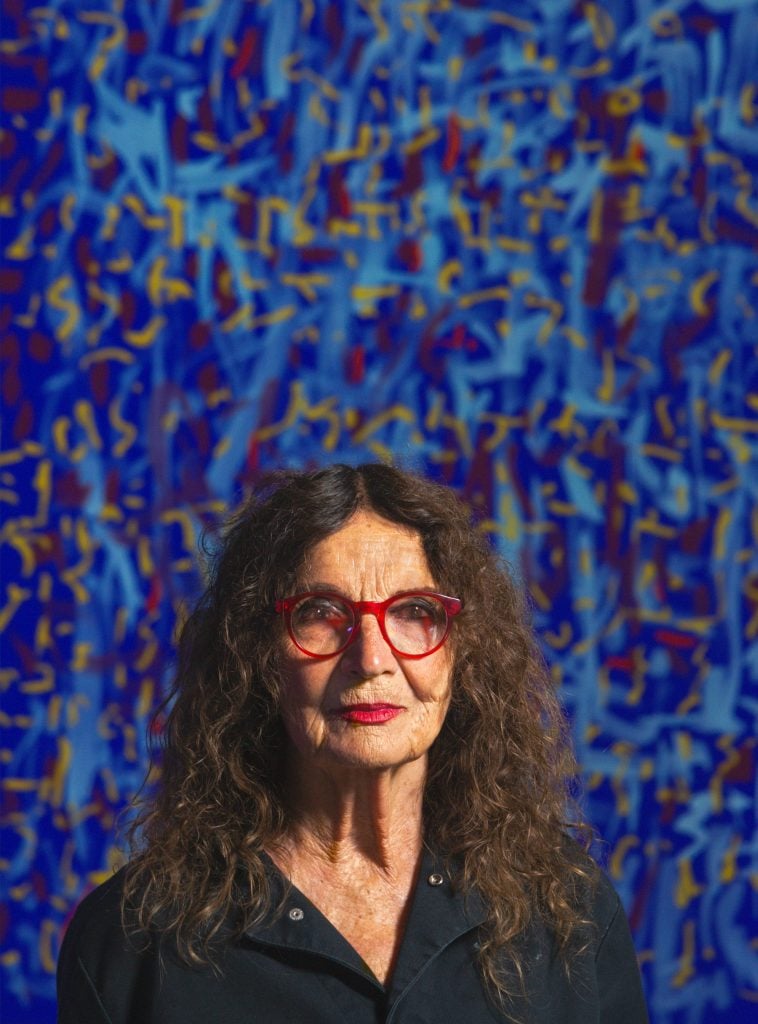
Lita Albuquerque is the Queen of the Now. It’s a nickname a colleague gave the 78-year-old artist known for her colossal, ephemeral art interventions on remote landscapes. The name suits her well.
During a visit to her Los Angeles studio on a sunny day this past June, Albuquerque invited me to participate in a short meditation—a recitation of our cosmic address—soon after I’d arrived. A cosmic address is used by astronomers (and the artist) to describe precise locations in the universe. It’s an incantation Albuquerque uses to place herself in the here and now and she’s recited it daily for decades.
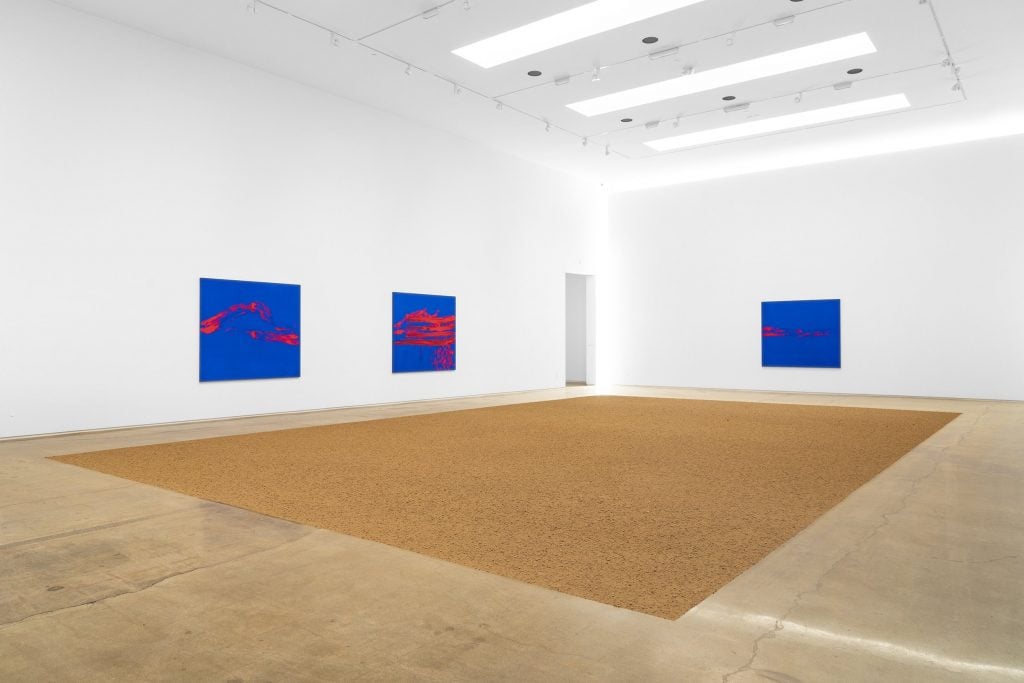
Installation view “Lita Albuquerque: Earth Skin” 2024. Courtesy of the artist and Michael Kohn Gallery.
We closed our eyes, and Albuquerque began: “We are two women taking in a brick building in the grid of the city of Los Angeles in the state of California, in the United States of America, in the northern hemisphere of planet Earth, which is located the third planet from our sol star nestled in the Orion arm of our Milky Way galaxy. Next to the Milky Way galaxy is a cluster of galaxies within the Virgo cluster of galaxies containing billions of stars, billions of galaxies, which is within Laniakea, which in Hawaiian means immense heaven, a supercluster containing tens of billions of galaxies, which is within our universe.”
She paused and began moving us backward: “We go back to the super great cluster, to the Virgo cluster to the Milky Way galaxy, nestled in Orion’s arm is our solar system, our planet third from our sol star back to the Northern hemisphere, back to the continent of the Americas, the country of the United States of America, state of California, the city of Los Angeles. We’re in a brick building. Two women are talking on Friday, June 14th of the year, 2024 at 11:01 AM.”
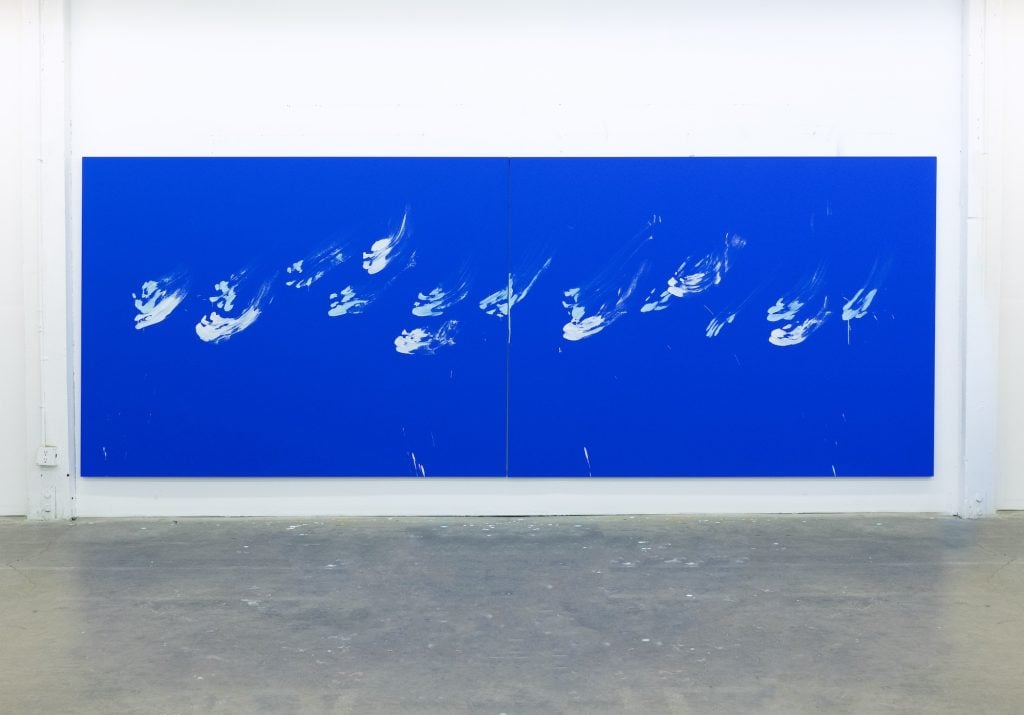
Lita Albuquerque, She Brought Us To The Pacific Ocean And Said, “Here, This Is Where You Were Born.” (2024). Courtesy of the artist and Michael Kohn Gallery.
The meditation felt the most sensible way to be introduced to the artist whose works have brought the cosmic down to human scale for decades. Albuquerque was born in Santa Monica in 1946 to a Tunisian Jewish mother and spent her childhood between Tunisia and Paris. Back in California in the 1970s she emerged as a potent creative force—and one of the few women artists—engaged in both Land Art and Light & Space movements. Over the decades, her works have taken her around the far corners of our earth, from the deserts of Saudi Arabia (a 2020 installation at Desert X) to the Great Pyramids of Giza (her 1996 installation Sol Star at the Sixth International Cairo Biennale) to Antarctica (a 2006 expedition for install Stellar Axis, a work made up of 99 fabricated blue spheres). Much like the cosmic address, her works have a way of zooming out to the far reaches and back into the smallest grain of sand, of letting the ancient past and the bodily present sync.
In the past year, she has been working at an incredible clip. Albuquerque recently opened “Earth Skin” a solo exhibition with Michael Kohn Gallery in Los Angeles (through October 19) which encompasses a new installation and series of paintings. The exhibition is part of 2024 Pacific Standard Time and distills many of the themes the artist has been grappling with for decades. The sprawling interior of Kohn Gallery is dominated by her titular work Earth Skin, an installation of decomposed granite made into a precise rectangular form on the gallery’s floor. New paintings in ultramarine line the gallery walls around it. Gestural marks in bright red occur in some of these works, feeling both cryptic and immediate.
“Earth Skin is almost an optical illusion as though we’ve peeled the gallery’s concrete floor back and this mass of the earth is revealed,” she said “It’s very perceptual work.”
The exhibition coincides with a flurry of new installations and interventions for the artist after a period of recalibration. In 2018, Albuquerque lost her Malibu home and studio in the Woolsey wildfire. “That slowed me down,” the artist said, “But I’m back where I need to be.” For an artist with so much history, she remains ever-focused on the present.
When the Earth Became Her Canvas
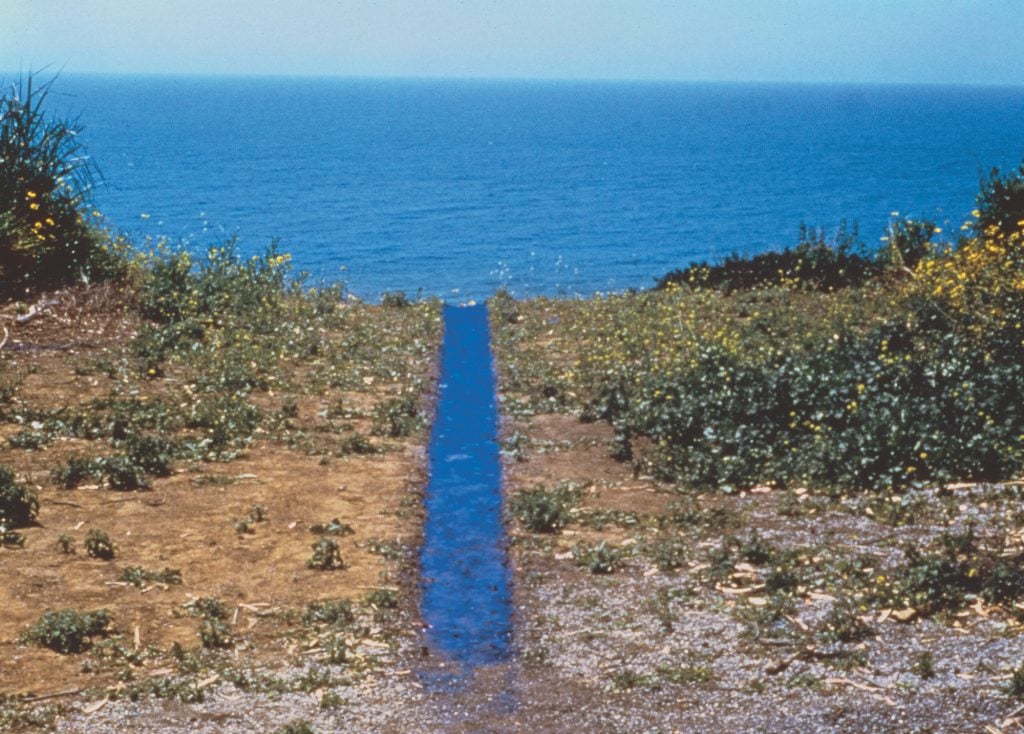
Lita Albuquerque, Malibu Line (1978). Courtesy of the artist.
In 1975, Lita Albuquerque was walking through the Metropolitan Museum of Art in New York when she heard someone call out “Pay attention to the feet!” She scribbled the line into her notebook, not knowing what it meant exactly. Sometime later she looked at the notebook and was struck by the words: look at the earth, look at where we’re standing on the Earth, she thought.
It was a moment of revelation for the artist who was at the time making abstract paintings. She’d also recently been moved by a gallery show of Robert Irwin’s work, in which the artist used black tape on a wall to create sculpture (“I thought ‘Oh my God, with a simple gesture, we see two volumes.'”) She began to see the ground beneath our feet as a place of engagement. In 1978, while living in an artist colony in Malibu, the artist made her first ephemeral intervention in the environment: a line of bright blue pigment on the bluffs overlooking the Pacific Ocean. Titled Malibu Line, the work drew together the sea, sky, and earth, giving the illusion of unity. But unlike many of her Land Art peers, whose interventions were made to stand the tests of time, Albuquerque wasn’t set on permanent alteration. “They were trying to conquer. I am the opposite. I do something that points to the moment,” she explained. A few years after its creation Malibu Line disappeared, lost to the sea air and new growth of the earth.
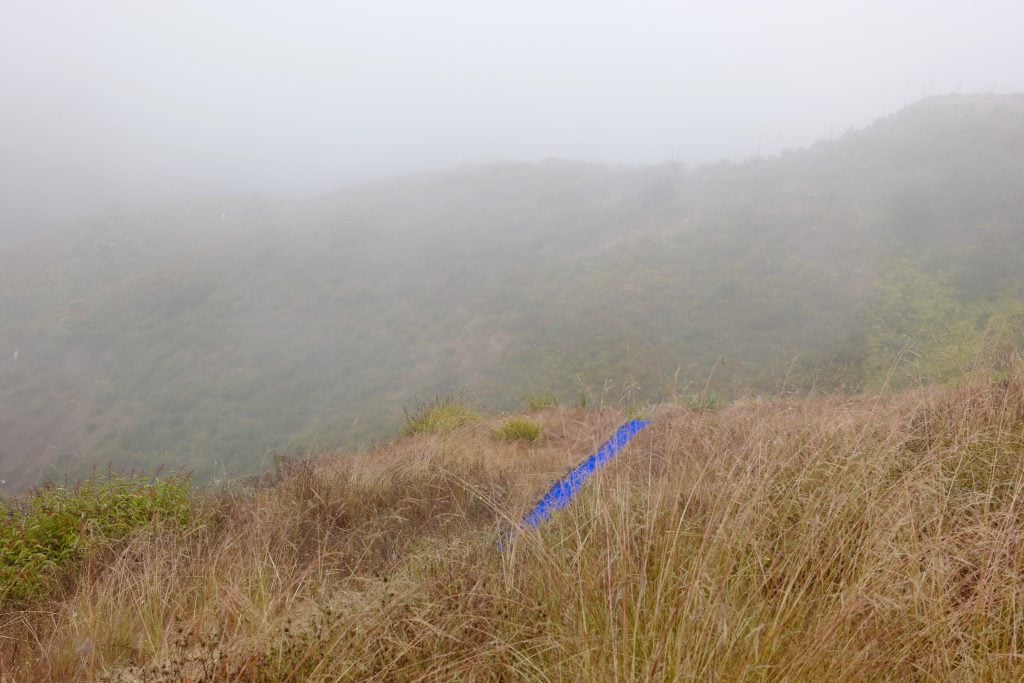
Lita Albuquerque, Malibu Line (2024). Courtesy of the artist.
In June, the artist created a new version of Malibu Line (2024), a counterpoint to her original work made some 46 years ago, accomplished with the support of the Los Angeles Nomadic Division (LAND) and curated by independent Tunisian curator Ikram Lakhdhar. This version took form on the property of her destroyed home and studio (the site of the original installation is now private property). Made in June of this year during a week of intense fog, the blue line here was like a symbol toward an invisible horizon, while the fog conjured, poignantly, visions of smoke.
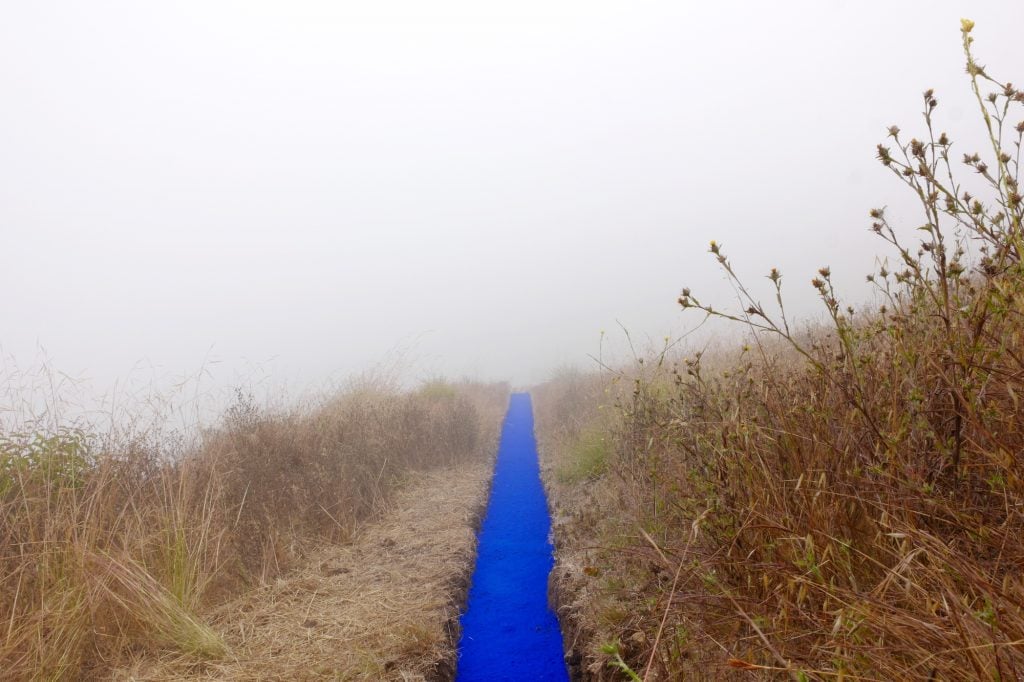
Lita Albuquerque, Malibu Line (2024). Courtesy of the artist.
In many ways, the original Malibu Line embodied a longing for Tunisia, where the artist spent most of the first 11 years of her life and where she was educated in a convent in Carthage overlooking the sea. With Malibu and Carthage at nearly the same latitude, the line into the sea was a way of reaching out toward memories.
“Tunisia is a very sensual country,” Albuquerque explained, “It’s about scent and it’s about color and it’s about how people are. I missed that. The work has always been about a retrieval of that land and memory and history.”
The horizon line has been a site of contemplation for the artist since she was a girl. “When I was young in my mother’s house, we lived on the beach. I remember looking out at the horizon and thinking my father would arrive. They were divorced and he lived in Paris,” she remembered. “One day I was looking at the horizon and thought of the verticality of my body against the horizon. It forms a cross. I wondered if that’s how symbols are formed—through the interrelationship of the human being and land.”
This time, Albuquerque has plans to create a version of Malibu Line in Tunisia, in Sidi Bou Said, a village known for its blue and white houses, in 2025. For the artist it will be a completion of sorts, a reminder that no matter where we are in the world we are sharing the same sky and are linked even from a distance.
“What I find fascinating is that all of my landworks are about a connection to either the horizon line or the stars above. It’s always about points of connection,” she explained.
Science and Art: The Earth is a Sculpture in Space
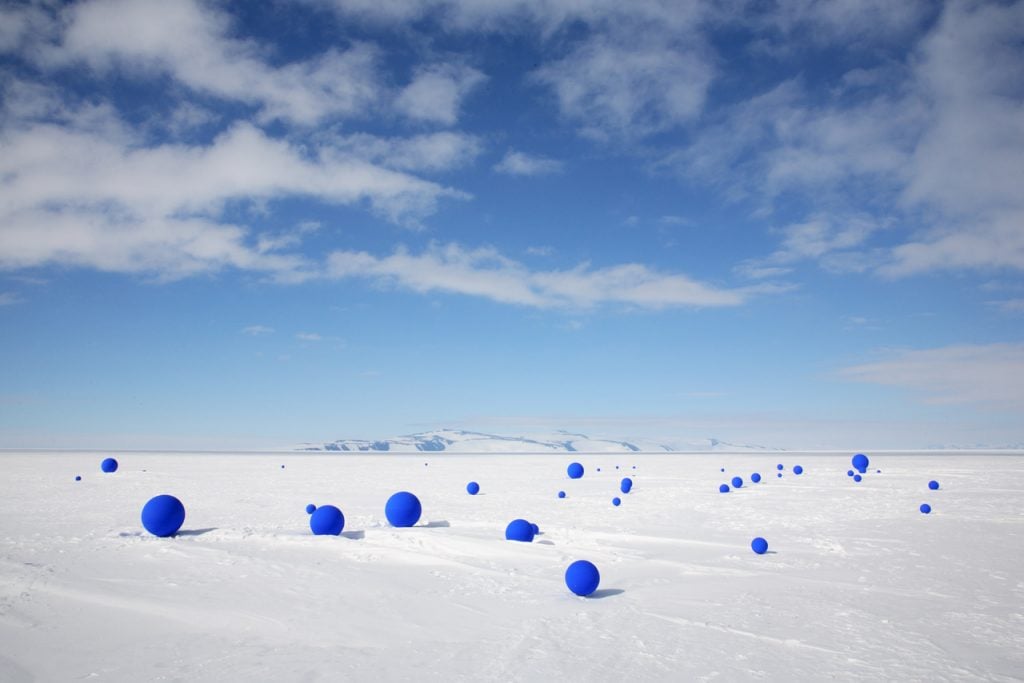
Lita Albuquerque, Stellar Axis: Antarctica (2006) photography by Jean de Pomereu, courtesy of the artist and the Nevada Museum of Art
For Albuquerque, art and science are two different ways of trying to understand humanity’s place in the cosmos. Her interest in science came together with her art practice clearly in 2006, when, with a grant from the National Science Foundation and support of the Nevada Museum of Art, Albuquerque and her team participated in an expedition to the South Pole to install Stellar Axis: Antarctica. The temporary installation consisted of 99 fabricated blue spheres which were situated to correspond with the 99 stars in the sky about Antarctica. As the earth rotated around the sun, the spheres’ placements traced the movement of the earth through the sky. Along with the artist and her team, the expedition included scientists and researchers. This summer, the Anderson Collection at Stanford University presented one of the remaining spheres along with an eight-minute film made on the expedition.
Stellar Axis: Antarctica was in some senses a parallel to the artist’s 1996 installation Sol Star at the Pyramids of Giza made for the 6th Cairo Biennale. There, she created 99 circles of ultramarine pigment on the desert sands. Ninety-nine as a number sees importance in Islamic cosmology, in 99 names of god.
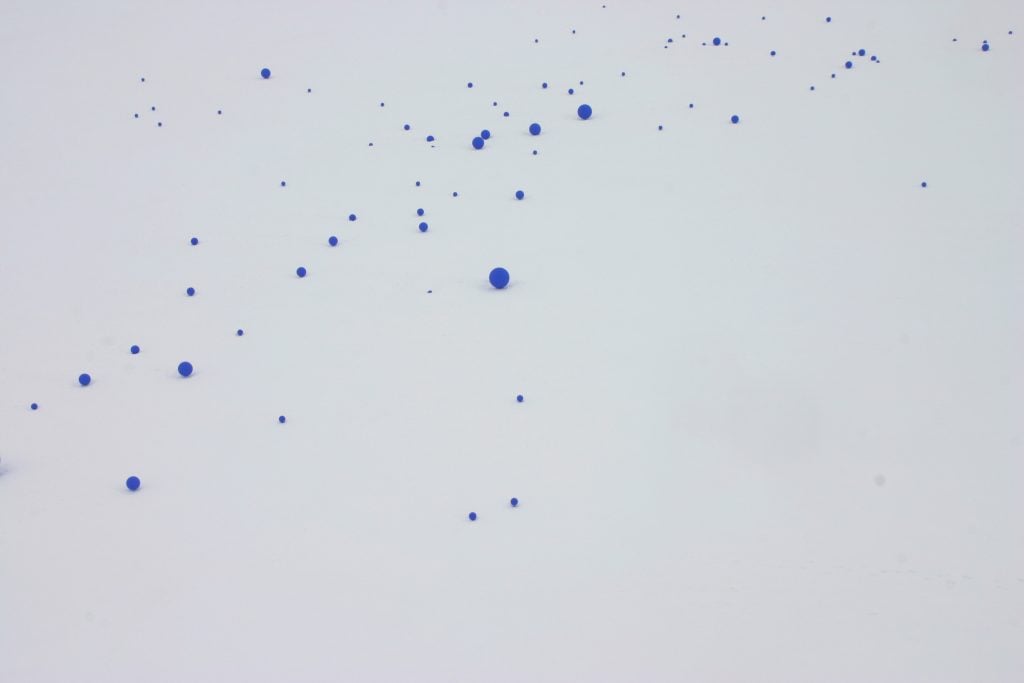
Lita Albuquerque, Stellar Axis: Antarctica (2006) photography by Jean de Pomereu, courtesy of the artist and the Nevada Museum of Art
That experience gave the artist a profound understanding of our place in the universe and art’s role within it. “I was near the pyramids in Egypt, seeing the earth in my mind from space, and the golden pyramids all aligned to the stars. I saw the pyramids surrounded by stars,” she said, “I thought: if the Earth is a sculpture in space, then the cosmos is an installation we partake in every day.”
Albuquerque’s passion for art and science is now taking a new form with an installation at Caltech in Pasadena, California, a leading global university for science and technology. On September 27, “Crossing Over: Art and Science at Caltech, 1920–2020” opens a first-of-its-kind exhibition at the university, which traces 100 years of the university’s history with presentations of contemporary artworks, Albuquerque’s among them. For her work, Albuquerque has covered a bridge on the campus with flickering pieces of gold leaf.
Back Into the Body

Lita Albuquerque, Spine of the Earth (1980). Courtesy of the artist.
“The studio’s usually like the ocean. Things change in and out so fast,” she said. The Los Angeles studio’s open industrial space is a far cry from the remote destinations of her land artworks but nevertheless allows her to conceive on a grand scale. The Woolsey Fire claimed Alburqueque’s archives and many of her works, as well as precious belongings of her mother, grandmother, and children. Until recently, she has navigated a semi-itinerant studio life dominated by complex logistics. But now she’s entered a renaissance of sorts. “I’m getting back into regular daily drawing and painting practice. And for me, that’s not just like on paper or the wall, but also on the ground, on the land,” she said.
For Albuquerque, who practices Kundalini yoga and runs and swims regularly, her archive of knowledge lives in her body. The body itself is often a key instrument in her works, though sometimes overshadowed by her massive installations. For instance, in recent years, she’s created a narrative centered on a fictional time-traveling astronaut, Elyseria, from the 25th century. The idea came to her during a bodywork massage. “All of a sudden I felt this creature next to me and I turned around and I said to myself, ‘Oh, 25th-century female astronaut.’ I started writing her story. “She’s come to the planet to remind us of our relationship to the stars, to the cosmos.”
While the character has sometimes manifested as a sculpture, Elyseria has also been performed in film and live performances by her daughter, the choreographer and dancer Jasmine Albuquerque such as in “Liquid Light,” a video installation that debuted at the 2022 Venice Biennale. (Lita is also the mother to artist Isabelle Albuquerque as well as a son).
Albuquerque doesn’t shy away from revisiting earlier works, renegotiating the human body’s place in an ever-changing world. She’s shown how the smallness of the body has its own monumentality. Her 2012 performance piece Spine of the Earth (2012) for instance involved 300 performers in red suits moving amid red smoke. It also included a skydiver. This performance was the artist’s reinterpretation of her 1980 earthwork of the same name made in El Mirage Dry Lake bed in the Mojave Desert of California.
“I thought instead of pigment, I’ll use people. I’ve always been taken by the hajj— where thousands of people go around the Kaaba” she said “Thousands of bodies become part of one sacred act. That scale is something you can hold in your mind, but the experience of that scale is the most powerful tool.”





